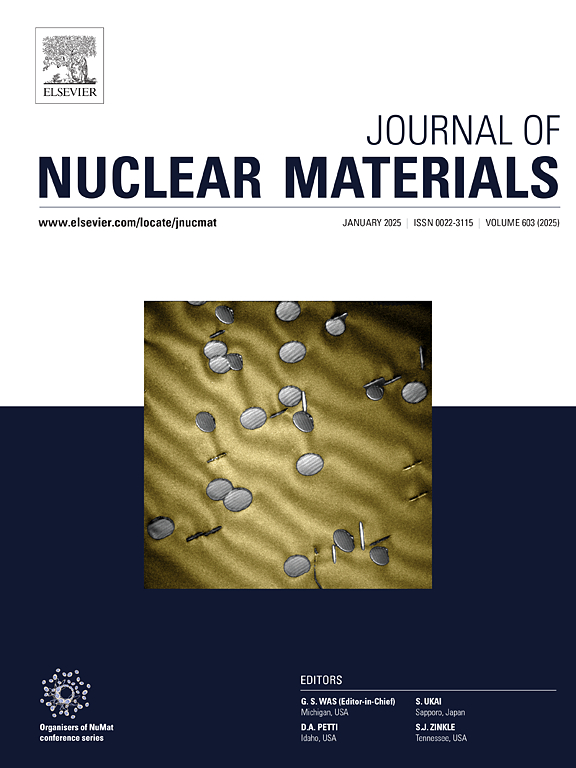Fracture behavior and grain boundary cohesion of alumina scales formed on ion-irradiated FeCrAl-ODS alloy
IF 2.8
2区 工程技术
Q3 MATERIALS SCIENCE, MULTIDISCIPLINARY
引用次数: 0
Abstract
The design of FeCrAl ferritic oxide dispersion strengthened (ODS) alloys is based on the formation of a stable alumina scale, which is expected to protect the alloys from extreme heat and corrosion in nuclear applications. To ensure reliable alumina protection in nuclear environment, it is indispensable to concern the radiation tolerance of the alumina scales formed on the FeCrAl ODS alloys. The present study investigates the effect of Fe ions irradiation on fracture modes and grain boundary cohesion of the alumina scales in conjunction with nano-impact tests and micro-double notch shear (DNS) compression tests. Pre-oxidation was carried out in air at 1000 °C to form an α-alumina layer on the surface of Fe-15Cr-7Al-0.5Y2O3–0.4Zr (wt.%) ferritic ODS alloy, followed by 6.4 MeV Fe3+ ion beam irradiation at 500 °C. Based on the microstructural characterization of the cross-sectional micrographs of nanoindentation imprints on the alumina scales, it was confirmed that the irradiation on the alumina scales resulted in significant intergranular fracture in nanoindentation, whereas the unirradiated alumina scales showed transgranular fracture. The elemental distribution around the alumina grain boundaries was elucidated with the aid of scanning transmission electron microscopy (STEM) and atom probe tomography (APT) observations, and obvious segregation of reactive elements (REs) and intergranular Ti/TiC precipitation were observed after irradiation, indicating the link between the microstructural evolution and the fracture behavior of the alumina scales. The detailed grain boundary cohesion of alumina scales before and after irradiation was accurately measured by the micro-DNS compression tests, and the results showed that the cohesion strength of the alumina decreased significantly after the Fe ions irradiation.
求助全文
约1分钟内获得全文
求助全文
来源期刊

Journal of Nuclear Materials
工程技术-材料科学:综合
CiteScore
5.70
自引率
25.80%
发文量
601
审稿时长
63 days
期刊介绍:
The Journal of Nuclear Materials publishes high quality papers in materials research for nuclear applications, primarily fission reactors, fusion reactors, and similar environments including radiation areas of charged particle accelerators. Both original research and critical review papers covering experimental, theoretical, and computational aspects of either fundamental or applied nature are welcome.
The breadth of the field is such that a wide range of processes and properties in the field of materials science and engineering is of interest to the readership, spanning atom-scale processes, microstructures, thermodynamics, mechanical properties, physical properties, and corrosion, for example.
Topics covered by JNM
Fission reactor materials, including fuels, cladding, core structures, pressure vessels, coolant interactions with materials, moderator and control components, fission product behavior.
Materials aspects of the entire fuel cycle.
Materials aspects of the actinides and their compounds.
Performance of nuclear waste materials; materials aspects of the immobilization of wastes.
Fusion reactor materials, including first walls, blankets, insulators and magnets.
Neutron and charged particle radiation effects in materials, including defects, transmutations, microstructures, phase changes and macroscopic properties.
Interaction of plasmas, ion beams, electron beams and electromagnetic radiation with materials relevant to nuclear systems.
 求助内容:
求助内容: 应助结果提醒方式:
应助结果提醒方式:


